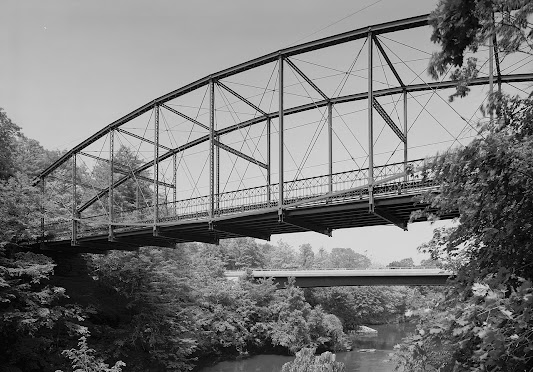English, Spanish was interchangeable in 1890s Duval County
 |
| The Berlin Bridge Company built three iron bridges in Duval County in 1890. The company erected this bridge in the 1890s but is not one from Duval County. |
In May 1890, a correspondent with the Galveston newspaper visited San Diego and was quite impressed with what he saw. The reporter described San Diego as "most decidedly Spanish or Mexican." But the residents, although coming from different places, all understood Spanish and English. So it was hard to tell whether an individual you met on the streets of San Diego was Spanish, Mexican, American, German, French, or some other nationality.
He observed that he witnessed a group of "fashionably dressed and well-educated ladies" in conversation." Their first sentence was in English and the next in Spanish, "with equal fluency." (The Galveston Daily News. (Galveston, Tex.), Vol. 49, No. 22, Ed. 1 Tuesday, May 20, 1890.)
In other happenings that year, the Duval County Commissioners Court issued a contract to the Berlin Bridge Company to build three iron bridges. The cost of the bridges would be $25,000. (Fort Worth Daily Gazette. (Fort Worth, Tex.), Vol. 14, No. 244, Ed. 1, Friday, June 13, 1890.) The bridges were primarily funded by the Texas Comptroller, who purchased $22,000 worth of bridge bonds. (The Galveston Daily News. (Galveston, Tex.), Vol. 49, No. 248, Ed. 1 Saturday, January 3, 1891.)
The newspaper account that appeared in the Fort Worth Daily Gazette does not mention the streets or roads where the bridges would be located; it does not mention which cities they would be found in. For example, one might have been Victoria Street in San Diego, which crosses the creek to the Casa Blanca. The story goes that the bridge on Victoria Street was torn down to use the metal in the war effort during World War II. ¿Quién sabe?
In 1890, when rainmakers were brought in to see if they could make rain to relieve an extended drought, Judge J. O. Luby was said to have observed the blasts from an iron bridge spanning 153 feet across the San Diego Creek. Although it was two and a half miles from Camp Edward Powers, where the rainmakers were headquartered, every boom the rainmakers released into the clouds made the iron bridge shake. (John C. Rayburn, "The Rainmakers in Duval." The Southwestern Historical Quarterly 61, no. 1 (1957).)
The Commissioners Court indicated the bridges would be both "ornamental and useful." (The Galveston Daily News. (Galveston, Tex.), Vol. 49, No. 236, Ed. 1 Monday, December 22, 1890.)
In addition to new bridges, other tidbits newspapers reported offer some idea of the goings-on in the county at the opening of the last decade of the nineteenth century. San Diego pharmacist Francisco Diaz, for example, was raising silkworms which had produced a "good supply of fine silk." (Brenham Weekly Banner. (Brenham, Tex.), Vol. 25, No. 19, Ed. 1, Thursday, May 8, 1890). Also, Jacob Long was growing tobacco for his own use, even miles outside of San Diego. (The Galveston Daily News. (Galveston, Tex.), Vol. 48, No. 337, Ed. 1 Sunday, March 30, 1890.)



Comments
Post a Comment
We welcome constructive comments and invite you to share your own research if you would like. Thank you.